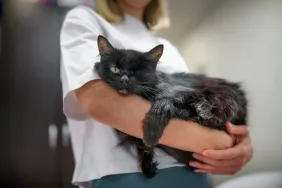Diabetes with coma in cats happens when a cat with diabetes is not treated properly or not treated at all. The situation can cause a coma.
Generally, the condition comes about if a cat has too much glucose in the blood. Additionally, a cat being given too much insulin can cause the condition.
If you see the signs of diabetes with coma in your cat, then get to a veterinarian for a proper diagnosis and treatment.
Here’s what you should know about the symptoms, causes, and treatments for the condition.
Symptoms of Diabetes with Coma in Cats
The condition produces a range of symptoms before a coma. For example, some of the most common symptoms include:
- Becoming uncoordinated
- Acting lethargic
- Seizures
- Shivering a lot
Ultimately, a cat suffering from the condition enters into a diabetic coma.
Causes of Diabetes with Coma in Cats

The cause of the condition is usually one of two things.
Firstly, a cat with too much glucose in the blood can develop the condition. This is called being hyperglycemic.
Secondly, a cat who is given too much insulin can develop the condition.
Additionally, older cats and obese cats are most at risk of developing the condition.
Treatments for Diabetes with Coma in Cats
Firstly, any cat who goes into a diabetic coma will need immediate medical attention. Call your nearest emergency vet if you notice this happening.
In cases where a cat has not yet gone into a diabetic coma, your vet will take the following steps. Firstly, your vet will ask about your cat’s symptoms. Secondly, your vet will carry out a full physical examination.
Thirdly, blood and urine tests will be ordered. Additionally, a serum glucose sample can highlight your cat’s blood sugar levels.
Unfortunately, cats who suffer from this condition usually require hospitalization. This is so that they can be given intensive treatment. This can involve intravenous fluid therapy and breathing support.
Additionally, any underlying conditions will be treated.
Generally, cats with this condition are kept in hospital until their blood glucose levels return to normal.
Ultimately, prevention is better than cure with this condition. So be on the lookout for any signs of diabetes in your cat. You can read more about the condition here.
Have you ever cared for a cat who suffered from this condition? How did your vet help your cat recover? Let us know in the comments section below.









